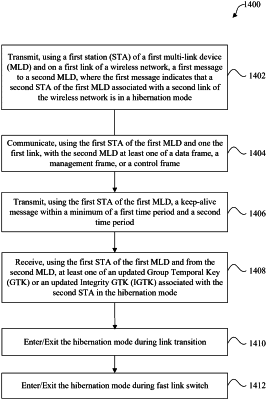| CPC H04W 52/0206 (2013.01) [H04W 28/0263 (2013.01); H04W 76/25 (2018.02)] | 20 Claims |

|
1. A multi-link device (MLD), comprising:
a first station (STA) associated with a first link of a wireless network and configured to communicate with a second MLD over the first link;
a second STA associated with a second link of the wireless network, wherein the second STA is in a first mode; and
one or more processors communicatively coupled to the first and second STAs and configured to:
transmit, using the first STA on the first link, a message to the second MLD indicating that the second STA is in the first mode, wherein the message comprises an association request transmitted during an association of the MLD and the second MLD and wherein the message further comprises a request for the second MLD to map one or more traffic identifiers (TIDs) to the first and second links;
transition the first STA from a second mode to the first mode, wherein the first mode causes the first STA to use less power than the second mode;
transition the second STA from the first mode to the second mode; and
transmit a frame, using the second STA, to the second MLD indicating that the second STA has exited the first mode.
|